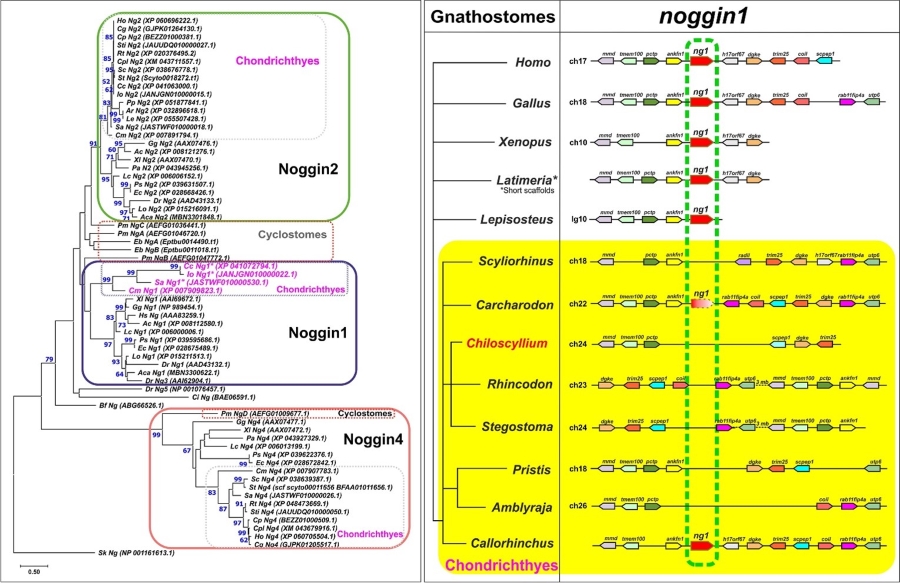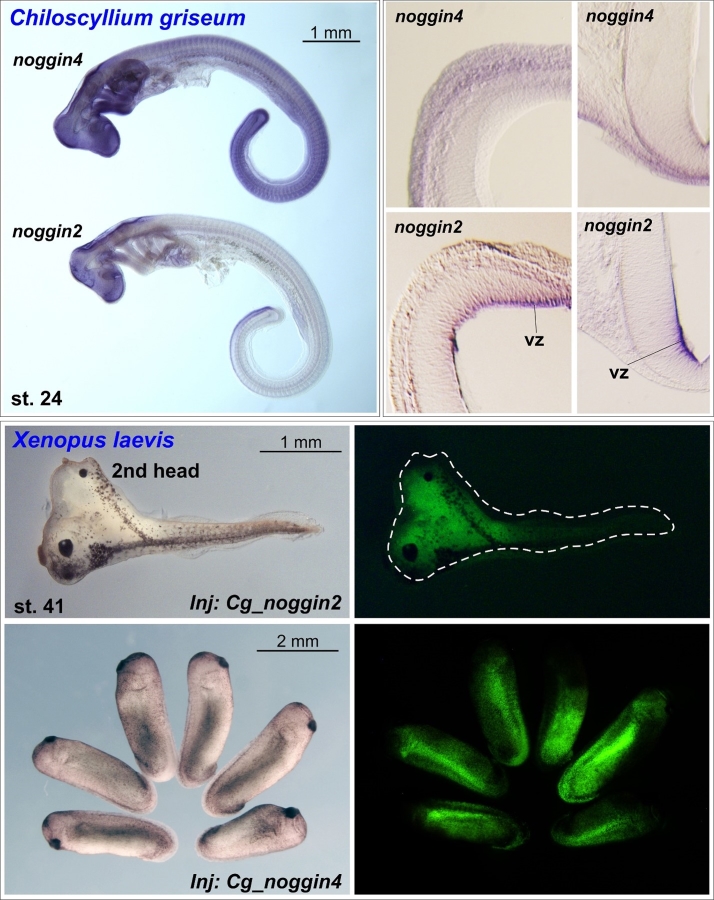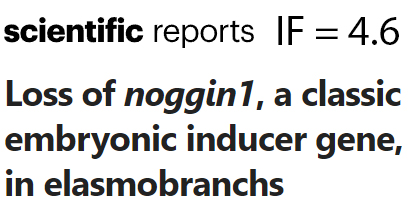Press-room / news / Science news /
The loss of the classical embryonic inducer noggin1 in cartilaginous fish may be associated with the formation of their unique skeleton
The discovery of the neural inducer Noggin1 in 1992 was one of the most important events in the history of molecular developmental biology. Subsequently, several genes of the Noggin family were discovered and described in vertebrates, which appeared as a result of genomic duplications in ancestral vertebrates and differed in their expression patterns and functional properties. A series of studies carried out at the Laboratory of Molecular Bases of Embryogenesis of the Institute of Bioorganic Chemistry, Russian Academy of Sciences, in 2006-2020, was devoted to the study of Noggins in vertebrates. The key roles of Noggins in the regulation of intracellular signaling cascades and a wide range of developmental processes, including the development of the telencephalon unique to vertebrates, have been demonstrated.
An unexpected result of the analysis of the phylogeny and local genomic synteny of Noggin genes in vertebrates was the identification of the absence of the noggin1 in the majority of cartilaginous fish (sharks and rays) - the most ancient representatives of modern gnathostomes (Figure 1). All three noggin paralogues are present only in the most basal branch of cartilaginous fishes, the superorder Holocaphali, which indicates the secondary disappearance of noggin1 in more evolutionarily specialized representatives of the group. Among Elasmobranchs, an altered sequence of the noggin1 gene was found only in the dogfish (Squalus acanthias), but the mRNA of this gene was absent in transcriptomic databases. Noggin1 pseudogenes containing stop codons within the open reading frame were found in the genomes of the shortfin mako shark Isurus oxyrinchus and the great white shark Carcharadon carcharias. Thus, in representatives of cartilaginous fish, a successive series of reductions in the noggin1 can be observed: starting from a weakening of expression/function in the most basal representatives of the group (C. milii and C. acanthias), through pseudogenization (C. carcharias and I. oxyrinchus) to complete elimination from the genome (most of the analyzed representatives of Elasmobranchs).
One of the key properties of the Noggin1 protein is considered to inhibit the activity of the BMP signaling cascade involved in the formation of the vertebrate skeleton. Since the loss of the noggin1 gene in cartilaginous fish is a unique situation among vertebrates, it has been hypothesized that the absence of noggin1 is associated with the development of a unique cartilaginous skeleton in representatives of this group. In the absence of the possibility of conducting direct functional experiments on embryos of sharks and rays (embryos develop in eggs with a very dense shell in seawater), this hypothesis has indirect confirmation in experiments on modulating the activity of Noggin and BMP in embryos of mice, chickens and amphibians. Increasing the expression level of noggin1 in mice, as well as inhibiting BMP activity in chicken embryos, led to suppression of the formation of cartilage tissue. Inhibition of noggin1 expression in mice results in delayed or suppressed development of a number of ossifications. These facts indirectly confirm the hypothesis put forward.
The expression of the shark noggin2 and noggin4 was examined in embryos of the gray catshark Chiloscyllium griseum (Figure 2). Noggin2 and noggin4 were found to be expressed in the brain and growing tail of shark embryos. In the head structures, noggin4 is expressed diffusely, while noggin2 is expressed in the cells of the ventricular zone of the ventricles of the brain. In addition, noggin4 is expressed in somites of the trunk and tail. These expression patterns of noggin2 and noggin4 are consistent with the expression of their orthologues in other vertebrates. The functional properties of catshark noggin genes also correspond to the previously described properties of their homologs of other gnathostomes. Noggin2 demonstrated the ability to induce additional body axes in X. laevis embryos, while noggin4 showed no such inductive ability.
Thus, the article describes a unique example of the loss of one of the key gene regulators of early ontogenesis in cartilaginous fish.
The work was carried out with technical support from colleagues from the scientific department of Moskvarium and published in Scientific Reports.

Figure 1. Analysis of the phylogeny of vertebrate Noggin proteins and evidence for the absence of the noggin1 gene in most cartilaginous fishes using local genomic synteny analysis.

Figure 2. Analysis of the expression of the noggin2 and noggin4 in gray catshark embryos and study of their functional activity (the ability to induce secondary body axes) in clawed frog embryos. vz – ventricular zone
february 19


